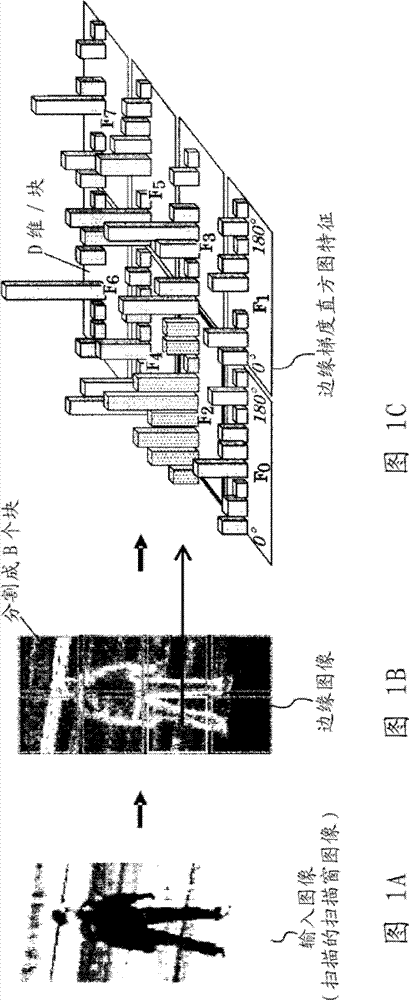Feature Quantity Calculation Device, Feature Quantity Calculation Method
A computing device and feature quantity technology, applied in the field of computer vision, can solve the problems of overlapping, increase in misjudgment, etc., and achieve the effect of high effect and high misjudgment
- Summary
- Abstract
- Description
- Claims
- Application Information
AI Technical Summary
Problems solved by technology
Method used
Image
Examples
Embodiment approach 1
[0085] First, various technical terms in this embodiment will be described.
[0086] "Pixel value" contains the brightness value.
[0087] "Edge strength" is information indicating the degree of change in pixel values. The edge strength is quantitatively represented by an "edge strength value" indicating the amount of change in the pixel value.
[0088] "Edge direction" means an edge gradient, and is the direction in which the edge strength changes. The edge direction is expressed quantitatively by the "edge direction value" which represents the direction in which the pixel value increases most in angle.
[0089] "Edge direction group" is a group of edge directions at a plurality of positions in which a predefined specific configuration relationship exists. The edge direction group is represented by a group of edge direction values at each position.
[0090] The "correlation value" is information that quantitatively indicates the degree of correlation of edge intensities...
Embodiment
[0183] In this embodiment, how to define the dimensions of the histogram is arbitrary. Therefore, coHOG, LBP, etc., which are applicable and applicable to conventional methods, consider various feature quantities of two or more pixels. For comparison, non-patent document 1 (Dalai's HOG) was compared with scoHOG of a conventional method, and the effectiveness of this embodiment was verified.
[0184] Figure 15 It is a figure which shows the result of the accuracy effect verification using the feature quantity calculation apparatus 100 of this embodiment in the form of a table.
[0185] As the database used in the experiment, the INRIA dataset proposed in Non-Patent Document 1 and commonly used for algorithm evaluation of person detection is used. As images for learning, 2416 person images and 1218 background images without people are prepared. Regarding the background image, rectangular images of 10 parts randomly cut out of 1218 prepared images were used as background samp...
Embodiment approach 2
[0228] Embodiment 2 is an example of a case where a feature such as an LBP (Local Binary Pattern) feature is used instead of an edge direction value as a feature type for constructing a histogram feature.
[0229] Figure 17 It is a block diagram showing the configuration of a feature quantity calculation device according to Embodiment 2 of the present invention. right with Figure 5 The same constituent units are assigned the same reference numerals and descriptions of overlapping parts are omitted.
[0230] Such as Figure 17 As shown, the feature calculation device 200 includes a feature calculation unit 220 , a histogram creation unit 130 , and a histogram connection unit 140 .
[0231] The feature amount calculation unit 220 calculates an LBP feature from the input image data, and combines the above-mentioned LBP features of a plurality of pixels to calculate a feature amount between pixels.
[0232] Figure 18 is a block diagram showing the configuration of the feat...
PUM
 Login to View More
Login to View More Abstract
Description
Claims
Application Information
 Login to View More
Login to View More - R&D Engineer
- R&D Manager
- IP Professional
- Industry Leading Data Capabilities
- Powerful AI technology
- Patent DNA Extraction
Browse by: Latest US Patents, China's latest patents, Technical Efficacy Thesaurus, Application Domain, Technology Topic, Popular Technical Reports.
© 2024 PatSnap. All rights reserved.Legal|Privacy policy|Modern Slavery Act Transparency Statement|Sitemap|About US| Contact US: help@patsnap.com










